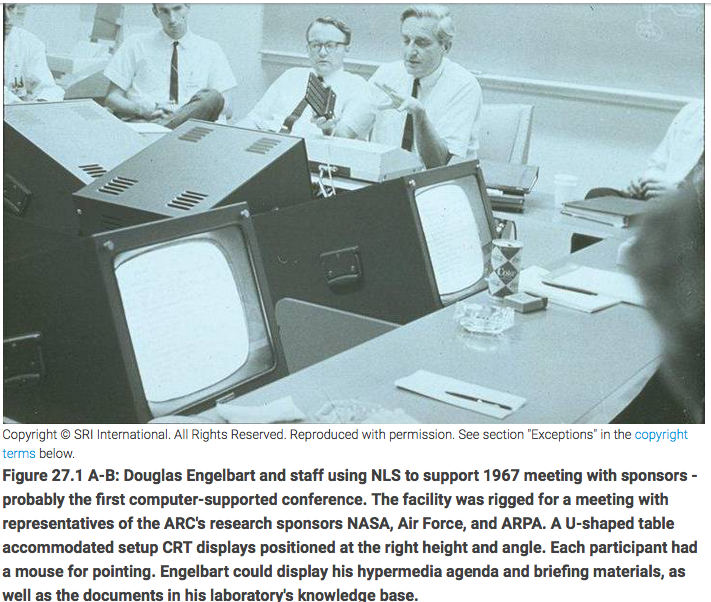Currently, I am working on a new “science of cognitive computing” curriculum for IBM with our partner universities and others to allow people of all ages to design, build, understand, and work with cognitive mediators. The curriculum is inspired in part by the work of Douglas Engelbart, an American engineer and inventor, and an early computer and Internet pioneer, who urged us to work quickly to augment human intellect to address complex, urgent problems.
Initially, we plan to use the curriculum to show people how to design and build cognitive mediators that augment their personal and professional memories and suggest profitable connections and conversations between people – a type of relationship-oriented computing. Later, we plan to use the curriculum to help people understand how intelligence (capabilities to perform useful tasks) develops in people and machines using specific data sets and learning algorithms, both unsupervised (evolution) and supervised (culture). Finally, we plan to use the curriculum to help people explore how best to work with their cognitive mediators, individually and collectively.
Cognitive mediators begin to address some of the problems associated with “bounded rationality” in decision making – the condition noted by Herbert Simon, a Nobel Prize laureate, was an American political scientist, economist, sociologist, psychologist, and computer scientist whose research ranged across the fields of cognitive psychology, cognitive science, computer science, public administration, economics, management, philosophy of science, sociology, and political science, unified by studies of decision-making. Cognitive mediators can help facilitate value co-creation and capability co-elevation interactions between entities at multiple scales.
People with their cognitive mediators can be thought of as systems in networks. For example, a smart service system can be viewed as a type of sociotechnical system in which most people are augmented with cognitive mediators to get and give service offerings. A wise service system goes beyond smart, to improve multi-scale entity interaction opportunities generation over generation improving individual and collective quality of life into the future.
Ideally, the new curriculum will inspire students and professionals to see the world more like Douglas Engelbart (opportunity to augmented the intellect of people individually and collectively to address complex, urgent problems) and Herbert Simon did (opportunity to use physical-symbol-systems to overcome some of the challenges faced by people with bounded rationality, who are making decisions in diverse types of organizations, ranging from families to businesses to nations). They both had a transdisciplinary or future-ready T-shaped perspective, and saw the world as interacting physical-symbol-systems with great potential to use technology to improve how people interact with each other in organizations. They both saw the world as people interacting socially and economically to solve problems, with more and more advanced technologies being designed to facilitate those interactions. Technology was seen by both Engelbart and Simon as a great enabler of improved interactions and decision-making between people in business and society, especially value co-creation and capability co-elevation interactions between entities at multiple scales, personal, business, and national levels of entity interactions.
A goal of some members of the artificial intelligence community is develop intelligent entities with self-awareness, and the capability to collectively establish appropriate, ethical rights and responsibilities between intelligent interacting entities. The best/classic starting point is the book The Sciences of the Artificial. For modern techniques, see the book Artificial Intelligence: A Modern Approach. A good/classic starting point to understand self-awareness in intelligent systems (physical-symbol-systems) is the online article Cognitive Economy.
A goal of some members of the cognitive science community is to understand the development and functioning of intelligence in people. The best/classic starting points are the two books Scripts, Plans, Goals and Understanding: An Inquiry into Human Knowledge Structures and Things That Make Us Smart: Defending Human Attributes in the Age of the Machine, as well as the online article Augmenting Human Intellect: A Conceptual Framework.
A goal of the community developing the new curriculum is to help all interested people design-build, understand, and work with their own personal cognitive mediator, to augment human intellect to address complex, urgent problems (Engelbart) and to systematically address some of the problems of bounded-rationality in decision-making (Simon). Recently, it has been suggested that the development of Software Social Organisms: Implications for Measuring AI Progress has benefits for the advancement of knowledge in all academic disciplines.
IBM has initially termed the new curriculum – “the science of cognitive computing.”
However, more broadly the new curriculum is intended to empower all interested people to learn about the design, engineering, management, public policy, and especially the science of personal and professional cognitive mediators (intelligent systems, cognitive computing, smart machines) for all business and societal roles.
The curriculum will be especially useful to learners who wish to understand and enhance the beneficial impact of cognitive mediators in business and society as part of smart service systems. The curriculum is being developed with the intention to help everyone understand and benefit from intelligent technology (cognitive computing) that enables the use of personal and professional cognitive mediators to enhance social and economic interactions between people.
References:
* Spohrer J, Banavar G (2015). Cognition as a Service: An Industry Perspective. AI Magazine. 36(4): 71-86.
* The complete Winter 2015 issue of AI Magazine can be accessed here: http://www.aaai.org/ojs/index.php/aimagazine/issue/view/212/showToc
* Spohrer J (2016). Innovation for Jobs with Cognitive Assistants: A Service Science Perspective. In “Disrupting Unemployment: Reflection on a Sustainable, Middle Class Economic Recovery,” editors Nordfors D, Cerf V, Senges M. Kansas City, MO USA: Ewing Marion Kauffman Foundation. Pp. 157-174.
* The complete book is available on Amazon here http://www.amazon.com/Disrupting-Unemployment-David-Nordfors/dp/152384583X
* Spohrer J, Bassano C, Piciochhi P, Siddike MAK (2016). What Marks a System Smart? Wise? Proceedings of AHFE Human-Side of Service Engineering (HSSE) Conference.
* The concept of smart service system has been an exploratory development of the USA National Science Foundation, and a number of major universities and companies, and government organizations from around the world.
* MIT-NSF Event: http://web.mit.edu/mitssrc/nsf/
* NSF LinkedIn group: https://www.linkedin.com/groups/5109582
* HICSS Conference tracks: https://www.linkedin.com/pulse/innovations-smart-service-systems-analytics-big-data-haluk-demirkan

